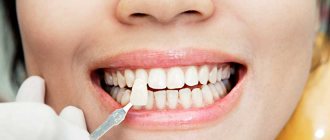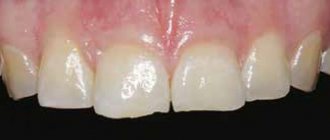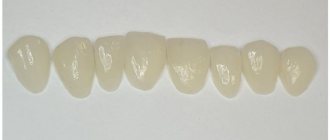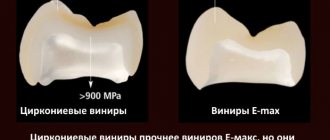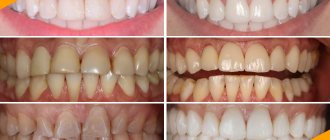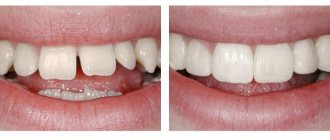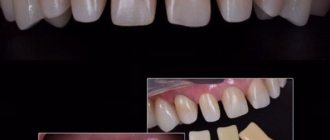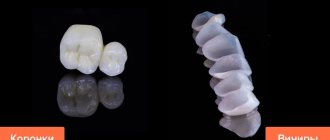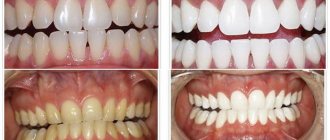What are veneers?
Thin plates made of ceramic or composite material that fit over the teeth and replace the outer layer. They are designed to hide aesthetic and functional dental problems and are a modern alternative to crowns, although they are very different from them.
In aesthetic dentistry I divide them into three types: +++
Types of veneers
What types of veneers are there? There are the following types of dental veneers:
- By installation option
- Direct (therapeutic) – veneers are formed in the patient’s mouth
- Indirect (orthopedic) - veneers are made in the laboratory using dental impressions
- By material type
- Ceramic
- Zirconium
- According to manufacturing technology
- Layer-by-layer application of mass, which is subsequently fired
- Injection molding under high pressure and high temperature
Lumineers
These are thinner plates that are glued to the teeth without grinding using special glue. Lumineers do not affect the functionality of teeth, but only add beauty to them. They are more expensive than veneers and, with proper care, last 30 years or more.
Depending on the type, veneers are made either in the mouth, directly on the patient’s teeth, or in the laboratory. The SmileStudio clinic has its own dental laboratory. Our dentists and technicians organize correct and disciplined work, thanks to which production and installation proceed very quickly.
At the SmileStudio clinic, the production and installation of veneers takes only 3-7 days!
The installation process is absolutely painless. And only high-quality materials are used for their manufacture, thanks to which they have a fairly long service life.
The service life depends not only on the materials used, but also on the type of records and their care.
- Ceramic ones last 30 years or more;
- Composite ones last 5-7 years;
- Lumineers last 30 years.
They are not at all different from real teeth, they are tightly attached to them, covering the front and bottom edges, which makes them completely invisible.
The color can be selected using a special Vita scale. This is a plastic strip that has ceramic tooth samples attached to it to make it easier to visually perceive the color.
What are veneers?
A veneer is a thin plate covering the vestibular surface of a tooth. The thickness of such a plate, as a rule, does not exceed 0.5 mm. Today there are two types of veneers:
- Made by dental therapists.
- Made by orthopedic dentists.
In fact, both types do not differ in anything except the material of manufacture. Therapeutic veneers are made from composite filling materials, and orthopedic veneers are made from ceramics.
If the question is which of the two types of veneers is better, then, undoubtedly, the best option would be a veneer made by an orthopedic dentist, because it is made of ceramics. And ceramics, as we know, have excellent aesthetic qualities. Ceramic veneers do not give themselves away; they are completely identical to natural teeth. In addition, they adhere better to dental tissues, which reduces the risk of developing a carious process at the site of contact with the tooth to zero.
Indications and contraindications for installing veneers
If we compare all three types, we can come to the conclusion that ceramic ones are considered the best option, since they are stronger than composite ones, cheaper than lumineers, and at the same time durable and natural. Each of these types has its own characteristics, advantages and disadvantages, care features and service life. But there is one important factor - indications and contraindications, which must be taken into account before installation.
Indications:
- Cracks;
- Uneven front teeth;
- Stains on healthy teeth;
- The front teeth are sensitive to irritants;
- Erased enamel;
- Darkening;
- Enamel fluorosis;
- Erosion of enamel.
Contraindications
Despite the great desire to have a Hollywood smile, there are a number of contraindications:
- Malocclusion;
- Periodontitis, periodontal disease, gingivitis in the acute stage;
- Absence of 6 or more chewing teeth;
- Presence of caries with complications;
- Presence of crowns;
- Removed nerves on front teeth;
- Dead or decayed teeth.
Getting veneers is an important step for anyone. You must take into account the indications and contraindications and be very attentive to all the nuances. But we must remember that many contraindications can be eliminated. First of all, you can solve other problems, and then safely proceed with the installation.
At the SmileStudio clinic, before installing veneers, each patient undergoes a full examination. The initial consultation is conducted by the chief physician of our clinic COMPLETELY FREE! After consultation and a full examination, the doctor prescribes treatment for teeth on which veneers will be installed in the future. And in our clinic all this is done absolutely free, quickly and efficiently!
Our highly qualified specialists will help you become the owner of a Hollywood smile and healthy teeth in the shortest possible time. Well-made and installed veneers look beautiful and natural, and they also help maintain healthy teeth and keep food and bacteria from getting underneath them.
Methods for making veneers
Application in layers. This method involves carefully pressing platinum foil onto the prepared tooth and layer-by-layer application of the ceramic composition. To avoid the risk of shrinkage and distortion, the foil fixes the finished solution by firing. The layer-by-layer application method is the least expensive.
Casting method. This method involves making a wax overlay on a plaster model and covering it with a special glass-ceramic composition. The structure is placed in a refractory mass, the wax is melted and burned out, after which the mass is removed. The final stage of the casting method is painting the veneers in a color identical to the patient’s tooth enamel and grinding. The great advantage of the casting method is the possibility of obtaining an aesthetic effect and structural strength.
Computer modeling method (using CAD/CAM technologies). This method of making veneers involves obtaining a digital model of the ground and adjacent teeth using a 3D scanner. Modeling of microprostheses is performed in a special computer program, after which technicians produce the design itself within 3-5 minutes. Next, the veneers are sanded and glazed, after which the product is considered ready. Computer modeling is considered one of the fastest methods for making veneers.
Indications for installation of veneers:
- Presence of visible gaps between teeth.
- Violation of the integrity of the enamel.
- Curvature of the dentition.
- Eliminate crowding of teeth.
- Loss of color and shine after removal of the dental nerve.
- Elimination of chips on enamel.
- Removing the yellow color of tooth enamel if whitening does not help.
Contraindications for installing veneers:
- A small number of teeth in a row or their absence.
- Curvature of the dentition.
- Presence of dental caries.
- Periodontitis.
- Bridges.
- Weak tooth enamel.
- Teeth grinding (bruxism).
- Pathological abrasion of teeth.
Do veneers damage teeth or not?
Let's destroy this incomprehensible myth that veneers ruin teeth!
Caries spoils teeth. Veneers, on the contrary, are a so-called protective suit against caries and external influences. According to the manufacturing method, they are of two types: direct and indirect.
Direct ones are made directly in the oral cavity, and indirect ones are made in a dental laboratory. It is necessary to take into account the fact that they are made from materials that are biocompatible with the body and do not cause allergies or other reactions.
And the high-quality German E-Max ceramics that we use does not cause any side effects, does not change its color and remains natural for many years.
Dentists recommend installation from the age of 18, since they cannot be placed on baby teeth. To install them, the teeth must be permanent. Many people often have the question of what to do if the tooth under the veneer begins to hurt. There's nothing wrong with that! Since they are installed from the outside, the back side allows any manipulation of the tooth.
We guarantee you 100% safety of dental procedures at SmileStudio. Our highly qualified doctors with 10 years or more experience do their work efficiently, painlessly and as quickly as possible.
Do your teeth hurt after getting veneers?
As we wrote above, if the installation of veneers was carried out efficiently, then pain should not bother the patient in principle. However, sometimes pain does occur. What can pain indicate after installation of veneers? Here are possible types of complications in which the patient may experience pain and discomfort:
- Individual reaction to low-quality fixative composition;
- Incorrect veneer size. Because of this, the microprosthesis can put pressure and injure sensitive gum tissue;
- High and unpleasant sensitivity after installation of veneers may occur in teeth from which too much enamel has been removed.
Eliminating all of the listed side effects will require both time and additional financial costs, and therefore it is so important that the installation of veneers takes place at all stages with strict adherence to technology!
Therefore, if you want the process of installing veneers to go without complications and you do not experience pain or other discomfort, you should always choose a clinic for the service carefully! Study reviews about the installation of veneers in Moscow in a specific clinic, find out about the reputation of its doctors and equipment.
History of creation, first use
In the 21st century, so-called veneers entered dentistry, which over time gained enormous popularity. Today this is the most important service in many dental clinics.
Have you ever thought about how and under what conditions veneers appeared?
So, in 1928, dentist Charles Pincus began thinking about creating the perfect smile for Hollywood actors. After all, no matter how good the teeth are, they look completely different on camera. That's why he attached ceramic plates made from denture powder, called veneers, to the actors' front teeth. The actors wore this plate only during filming, as they stayed on their teeth very poorly. But this was not a problem, because they helped create the perfect smile in the frame. It was thanks to Charles Pincus that the phrase “Hollywood smile” appeared, and the dentist himself was nicknamed “star dentist.” For 50 years, ceramic plates were used only in cinematography, but in the 80s a revolution occurred in dentistry - veneers appeared, which are becoming more popular year after year. They are different from their prototype, much stronger, and designed for use in the modern world. Today, veneers are thin plates made of ceramic or composite material that are placed on the teeth and replace the outer layer. Thus, they hide all dental imperfections and help you acquire a Hollywood smile.
When to install veneers on teeth
- for small chips of enamel,
- with curvature of the position of the teeth, but minor,
- if there are gaps in the row,
- in general, when the condition of the enamel is unsatisfactory - if it is weakened or has a dark shade that cannot be eliminated through the classical whitening procedure.
If the damage to the tooth is more serious, that is, if it is destroyed by more than 50%, affected by caries, or has large fillings on the front surface, veneers will not save you. In such cases, full prosthetics are required - for example, with crowns.
Chips on teeth - indications for restoration
Installation rules and service life
In order for dental onlays to last as long as possible, it is necessary that their installation is carried out correctly and that the natural incisors are not damaged. Installation of the overlays looks like this:
Stage 1 . First, the oral cavity is thoroughly sanitized: tartar and hardened plaque are removed, and diseases are treated.
Stage 2 . The next stage is the choice of material and application technique, selection of the required shade of the future enamel.
Stage 3 . After this, local anesthesia is applied, since the doctor needs to expose the neck of the tooth to take impressions and further ensure that the onlays fit perfectly.
Stage 4 . After this, they begin to carefully prepare the enamel, affecting only the top layer and avoiding cracks, chips or other damage.
Stage 5 . An impression is taken of the prepared incisors, which is then sent to the laboratory for the manufacture of veneers.
If lumineers are installed, the doctor glues ready-made, pre-selected overlays. In the case of composites, there is a kind of build-up of the surface of the processed incisors, which are then ground to obtain a smooth, shiny surface.
Stage 6 . After taking impressions, special temporary onlays are installed on the teeth, which the patient must wear until the onlays are made in the laboratory.
Stage 7 . When the veneers are ready, the doctor carefully glues them onto the previously prepared incisors.
Stage 8 . After this, an examination is performed, a slight correction of the bite for comfortable wear, and recommendations for further care are given.
The veneers are installed, and patients begin to worry about how long they will be wearable. Modern high-tech materials retain their properties for more than 20 years, subject to careful handling and regular visits to the dentist for examination and correction of emerging problems.
Flaws
Compared to ceramic veneers, products made from composite materials have a number of negative qualities:
- Compared to ceramic products, these plates have low aesthetic qualities. Sometimes after installation there is a clear difference between the color of the veneer and the natural color of tooth enamel;
- teeth with composite plates are quickly lost. Over time, composite veneers become dull, yellowing appears, and the shade may become darker. But plates made of ceramics and porcelain never change color, their shade is fully preserved throughout the entire period of use;
- Composite microprostheses have low strength. After installing them, it is not recommended to crack nuts, eat hard foods, vegetables, fruits. But products that are made of pressed ceramics or zirconium are characterized by increased strength; they do not collapse even under impacts;
- When performing layer-by-layer application of light-polymer material under artificial lighting in a dental office, it does not allow achieving the required shade, because increased tooth moisture reduces the quality of the base. In addition, there are a large number of colors of composite material for veneers, so many may have serious problems choosing the required shade. But in any case, no matter what color is chosen for the veneer, it will still differ from ceramic or porcelain plates.
If patients neglect their teeth, they injure them. Bad habits can lead to yellowing of veneers, as well as to breakage. In this regard, you will have to make a new veneer or crown for the tooth.
